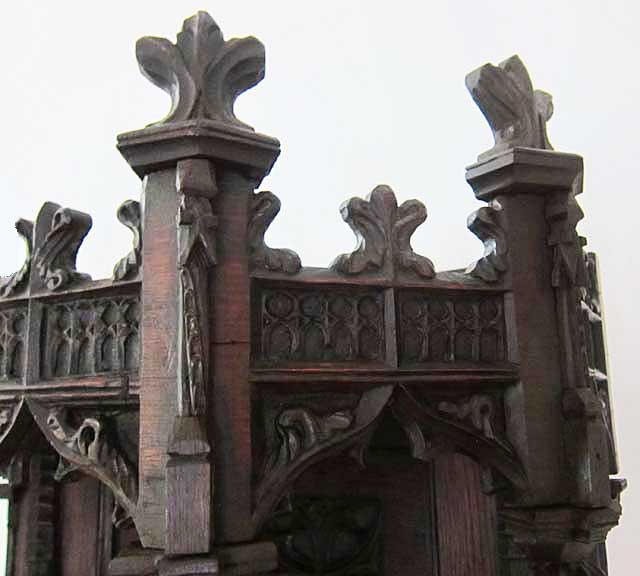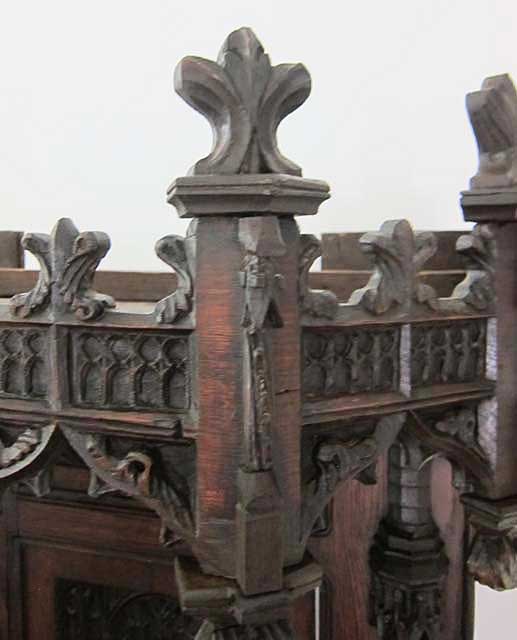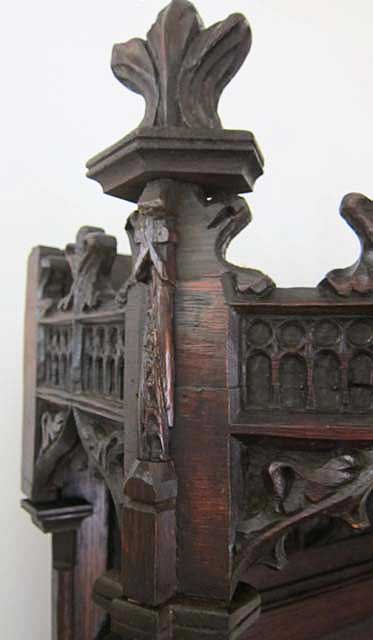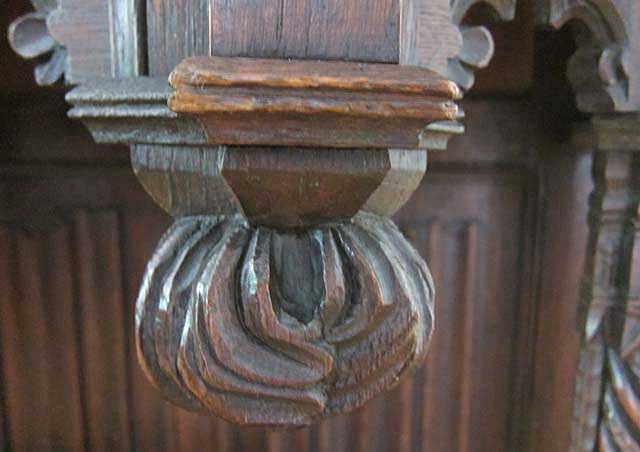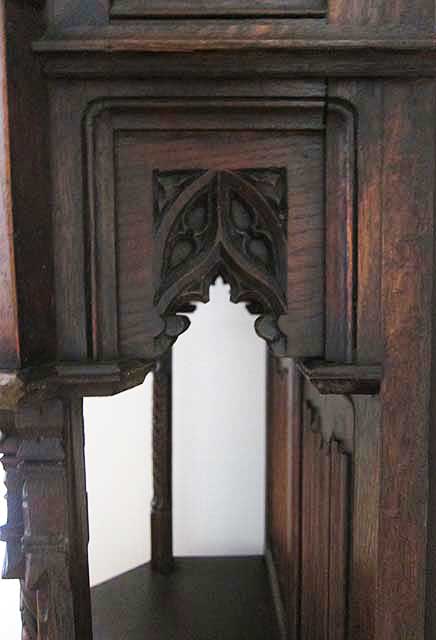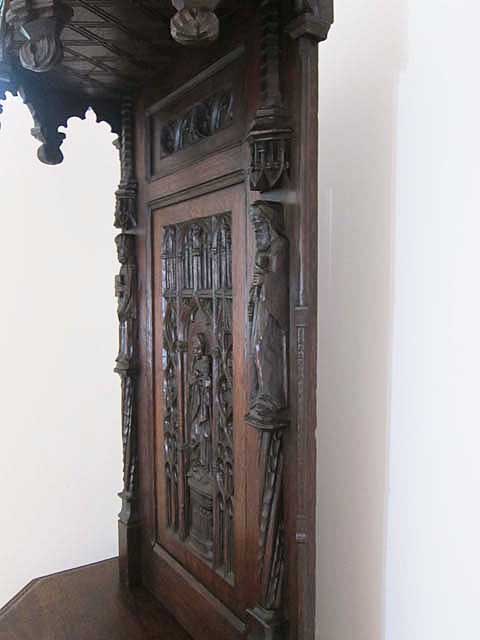
As cabinets go, the design for an argenterie is one of our favorites. Tall and slim, it has a small case at the center, designed to lock up the family silver or argent, from which the argenterie cabinet took its name. The top of the case doubles as a horizontal surface for displaying items such as our Gien vase that dates from around the same time as the cabinet. Above the case is a tall panel topped by a crown acting like a canopy and reflecting the hexagonal shape of the case and the pot-board at the base.
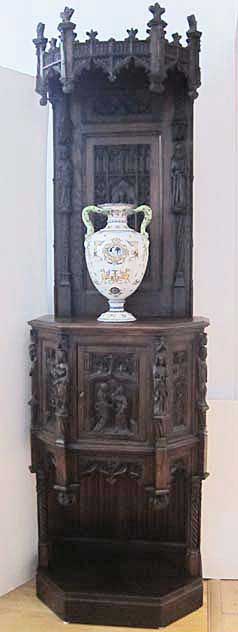
We cannot say that we have ever seen an argenterie in museums with collections of furniture dating to medieval times. So, we suspect that the argenterie was a 19th century invention developed during the revival of interest in Gothic architectural styles. The result is an ideal form on which to bestow huge amounts of complex ornamentation as on this piece. Plus, it offers the ideal place to lock up the family silver while displaying ceramics.
Even if the standard design for this type of tall cabinet was unknown in the Middle Ages, its origins can still be documented, thanks to Eugène Viollet-le-Duc. His interest in Gothic style went far beyond his role as architect and preserver of medieval buildings to involve curiosity about all manner of decorative and useful objects, including furniture. His books are full of line drawings along with explanations about medieval furniture and how it was used in religious as well as domestic settings. The following drawing, from the entry for Crédence from volume 1 of his Dictionnaire Raisonné du Mobilier*, shows a narrow cabinet with a locked case above the midpoint and a canopy at the top. He describes it as based on designs used at the Basilique Cathédrale Notre Dame d'Amiens. To become an argenterie in the sense of 19th century revival of Gothic design, it need only have the height doubled for the back portion above the case.
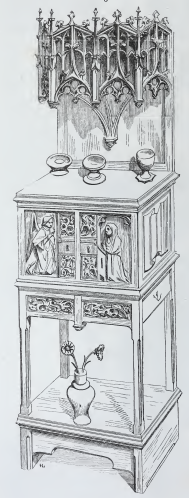
Before dwelling more on the stylistic details of this cabinet, we will discuss the story it presents. The connection to cathedral furniture, cited by Viollet-le-Duc, is especially interesting in this case since the theme of the piece is the Virgin Mary and the Visitation of the Virgin to her cousin, Elizabeth, at a time when both women were expecting children. As a subject from the Life of the Virgin, the Visitation has been a popular one with artists, especially in the Renaissance, as the following examples show.

by Mariotto Albertinelli(Uffizi, Florence)

by Piero di Cosimo(National Gallery, Washington, DC)
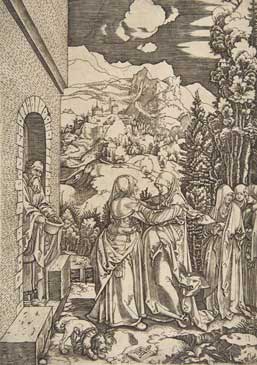
by Albrecht Dürer(Metropolitan Museum, New York)
In each of the scenes, the figures clasp hands and embrace partially, leaning toward one another with a sense of affection and a shared destiny. With their clothing draped elaborately, they impart a sense of dimensionality in spaces characterized by deep perspective, and in the case of the Piero and the Dürer, a richly detailed landscape.
A similar scene is presented on the door panel of our cabinet, in which the figures of Mary and Elizabeth are placed within an ogee arch. A sense of perspective is provided by the columns atop brick walls, forming the sides of the arch while receding from the viewer in a manner similar to Albertinelli's framework.
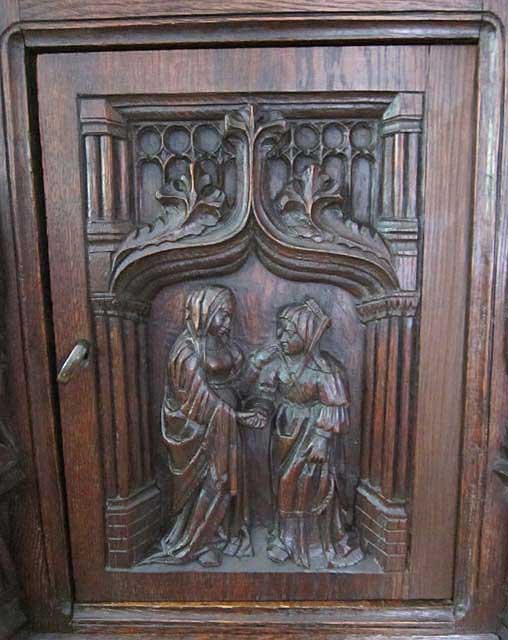
Carved from solid oak, the details of the figures of Mary and Elizabeth are remarkable in their intricacy and in conveying a sense of the tenderness and affection that must have characterized their meeting. The richly carved drapery seems almost fluid — as if the enthusiasm played out in the motion that has brought them together causes the clothing to billow around them.
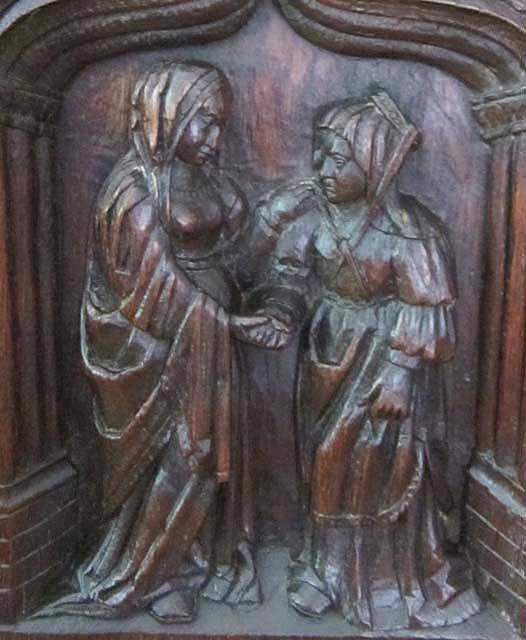
The details of their faces make them almost recognizable, in profile, as they engage with one another while expressing their emotions through gestures, their magnificently carved hands clasped firmly together.
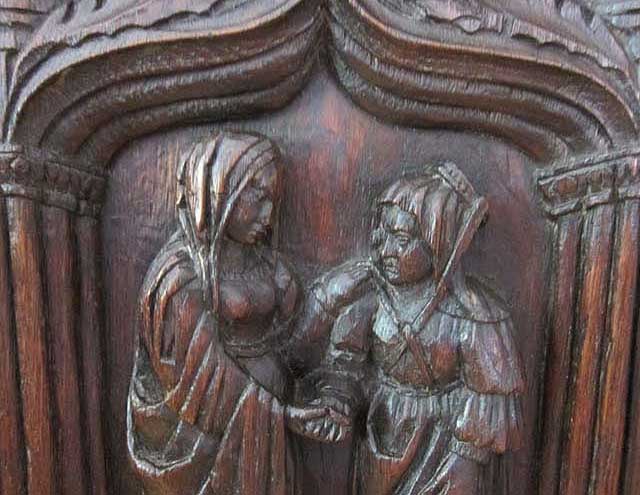
For another oak cabinet displaying exquisitely carved scenes from the Life of Mary, see Dressoir 5203.
The theme of the Virgin Mary is also present on the portion of the cabinet above the central case. Here, Mary appears by herself, framed within an elaborate arch with tracery or fenestrage on either side. Surrounding her and within that arch is a niche carved further into the panel and enhancing the sense of her presence in a three-dimensional space.
As in the scene with Elizabeth, the Virgin's drapery is elaborate and flowing. A portion is gathered in her grasp. She stands facing us, the viewer. Her face, intricately carved, is serene as she appears to gaze out at us. Her head is covered by her cloak. She holds a staff, perhaps to indicate she is walking along on her journey to visit Elizabeth.
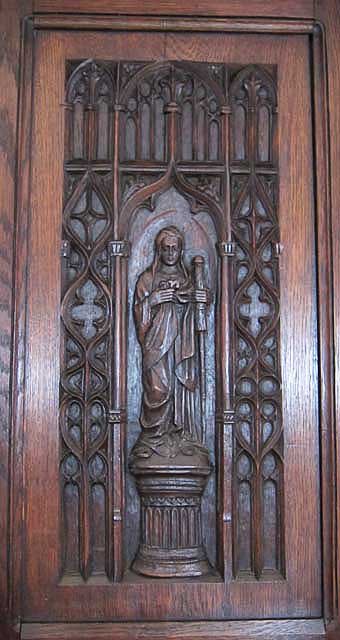
This view of Mary is not the classic portrayal found in the Middle Ages where the Virgin is shown wearing a crown and holding the Christ child on her left side. Her torso shifts gracefully into a curve to the right, such as the example from Notre Dame de Paris.
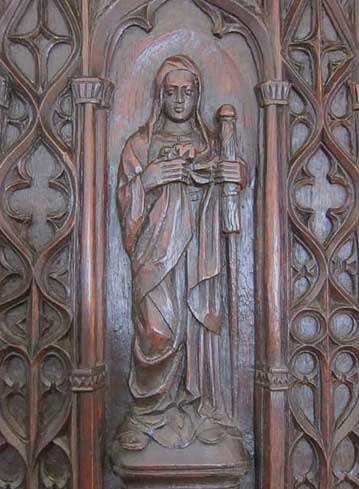
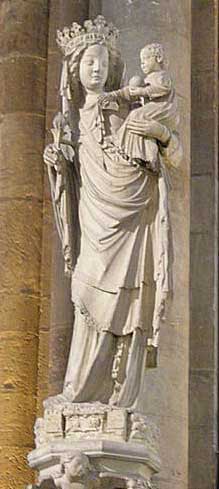
Poised atop a fluted column, her footwear is partially visible below her garments.
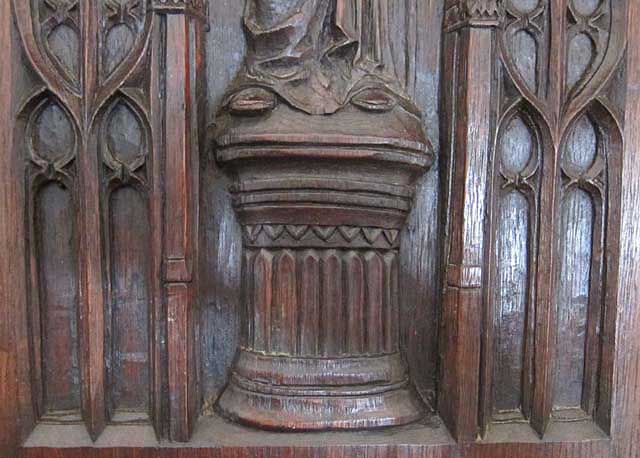
The depiction on this panel reminds us of Carlo Crivelli's painting of the Virgin Mary at the National Gallery in London, especially in terms of pose, costume, and facial expression.
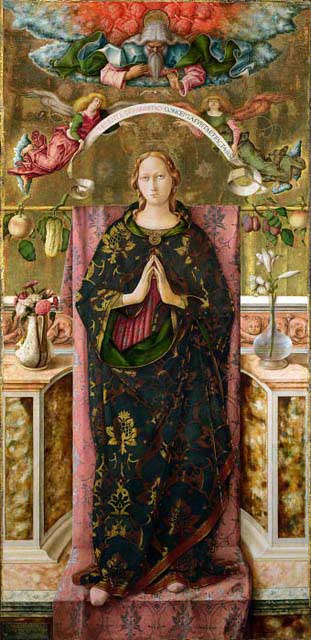
With the emphasis on the Virgin Mary, and a story from her early life, this cabinet was probably made for a religious institution or for a private person of devout faith. By the time we acquired it, the cabinet was in the Château du Temple in the Loire Valley, where we purchased other items such as Bed 5332B and Armoire 5332A (where more information is available about the history of the Château).
Looking beyond the story of Mary, however, this piece is rich in Gothic elements that bear closer examination.
As argenteries go, this is the largest one we have ever seen yet one with some of the most intricate carving, including that on the crown where it would be difficult to see without the aid of a stepladder. That anyone would carve such details to be displayed at a height making appreciation of them challenging is a testimony to the passion and artistry of the anonymous carver of this piece.
In overall style, the argenterie is Gothic, and within that style it is Flamboyant, meaning that it uses ogee or gracefully curving arches whose figures at their tops resemble a flame (the medieval French term for which is flambe). For more about this style, popular at the tail end of the Middle Ages and during the 19th century revival of Gothic, see the discussion on the Stylistic Origins page of this website.
All over the cabinet are beautiful elements of Gothic design, including the ogee arches framing open space of the crown and on the sides above the pot-board. Especially unusual is the elaborate crocketing along the outside of the arches at the front of the crown. Such crockets, made of figures representing curled acanthus leaves, extend the entire length of the arch rather than punctuating it at smaller intervals as we see typically on arches and spires.
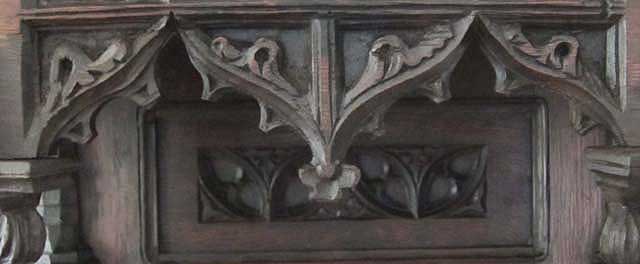
Mirroring the arches from the crown are arches below the case on the front of the argenterie. Instead of crocketing, the arches are framed by tracery enclosing mouchettes, that elliptically-shaped "work horse" of Gothic design used to fill empty spaces with delights for the eye.
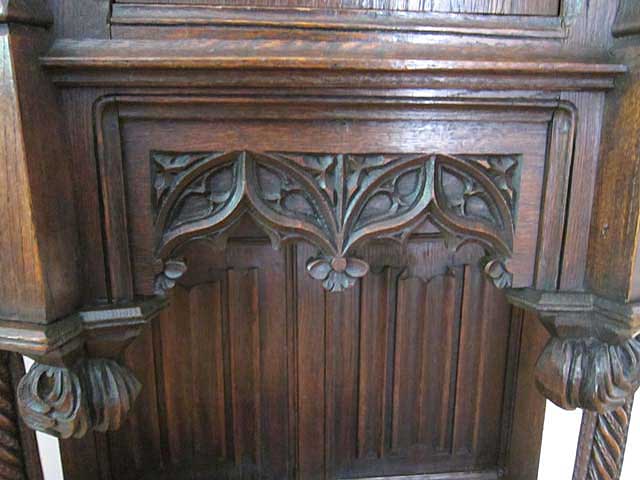
The arches on side panels of this lower part of the cabinet are similar.
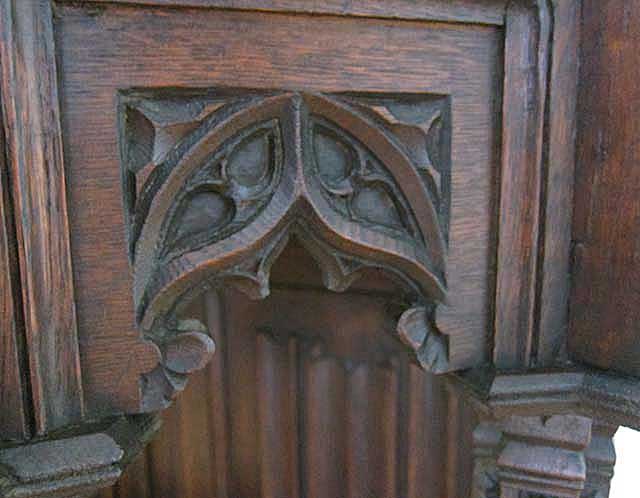
Mouchettes are the main feature for a panel of tracery above the central figure of the Virgin Mary and just below the crown.
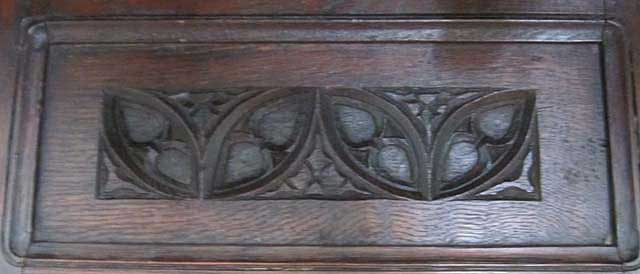
Elaborate tracery, contained within a tall arch, is found elsewhere on the cabinet, including the panels on the sides that angle away from the central door panel.
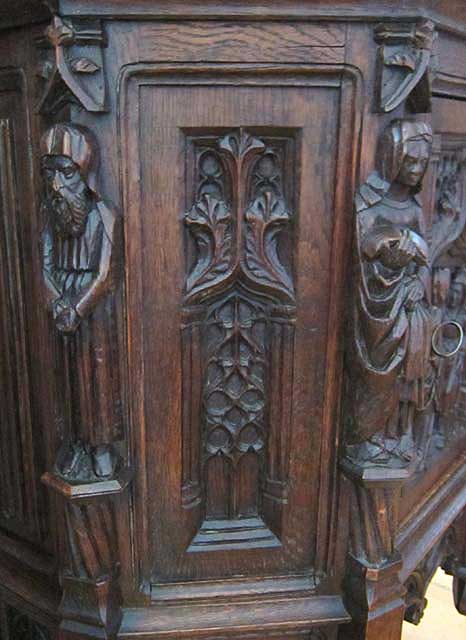
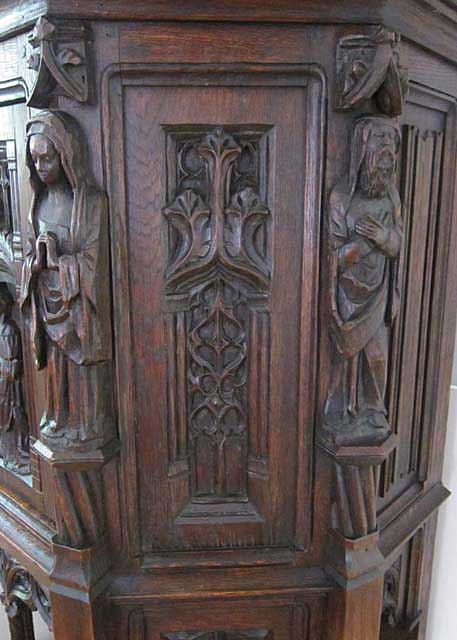
These panels are based on a tall ogee arch. The verticals forming the sides of the arch are in the form of columns as they were on the central door panel with the scene of Mary and Elizabeth. The panels are typical of Flamboyant Gothic in how they are structured: lancet arches at the bottom with arrangements of mouchettes above them, including within quatrefoils. For more about the ubiquitous lancet arch, see the Gothic section of our page on Stylistic Origins of our collection.
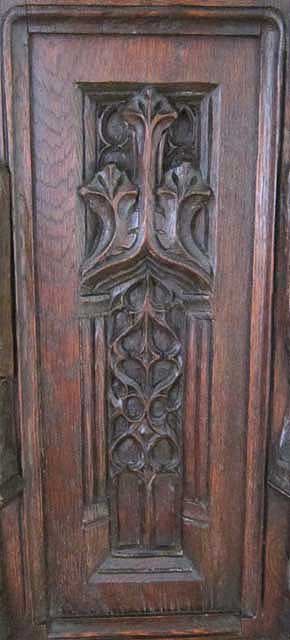
Again, the ornamentation of the main arches is unusual. Instead of crocketing on the slopes of the arches there are figures mimicking the central flame or fleur-de-lys pattern that forms the uppermost tip of the arch. At the top, the ornamentation on the slopes of the arch is again unusual in that it obscures underlying lancet arches, just as it does at the top of the arch surrounding the figures of Mary and Elizabeth on the door panel.
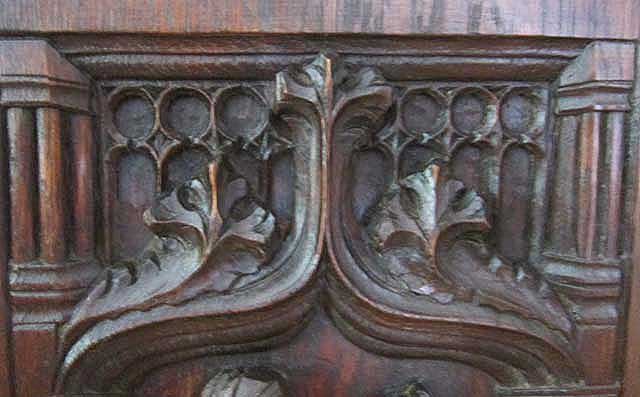
Lancet arches form the predominant decoration as a frieze around the crown of the cabinet. Each grouping of four lancet arches comprises a section whose boundaries are the sides or tops of the ogee arches below them.
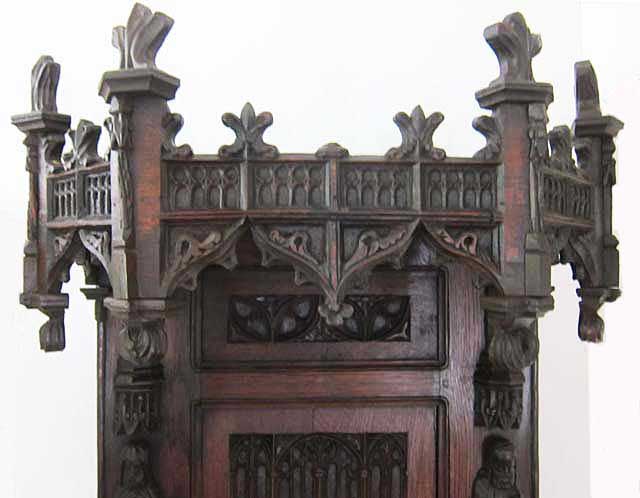
Each of the fleur-de-lys figures atop the frieze of lancet arches punctuates the top of an ogee arch after appearing to run up through the frieze of lancet arches. The exception is the exact center of the crown where it appears that the fleur-de-lys has broken off and been converted into a nub. Of the remaining ones, some have been repaired, presumably after having been knocked about during moves.
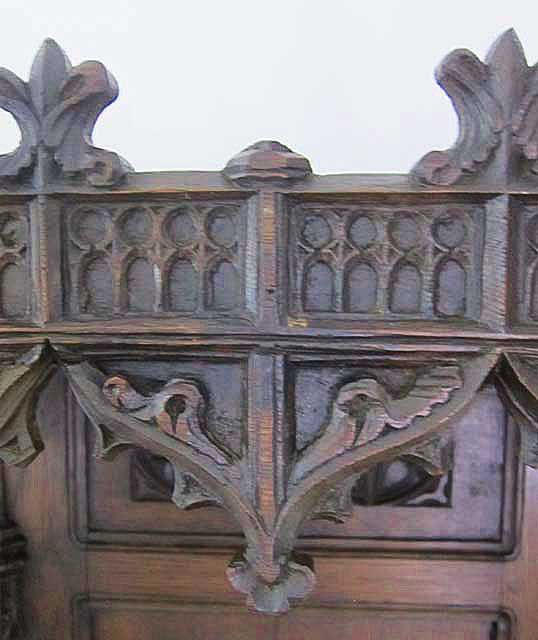
The intricacy of the carving of the lancet arches is challenging to appreciate by even the tallest among us, considering that they are over eight feet off the ground.

Returning to the central figure of Mary, she stands within an ogee arch. On either side are tall panels containing tracery elements seen elsewhere on the cabinet, including mouchettes and quatrefoils above lancet arches. The central ogee arch extends upward into a horizontal panel of tracery characterized by lancet arches in graduated heights at the center. Similarly, the sides of the arch within which Mary stands, are comprised of column clusters, one thin column of which also extends upward into the horizontal panel to divide the central panel from the side panels. It is as if she stands within one of the Gothic cathedrals named for her.

These panels above the figure of the Virgin evoke the stained glass windows of a Gothic cathedral.
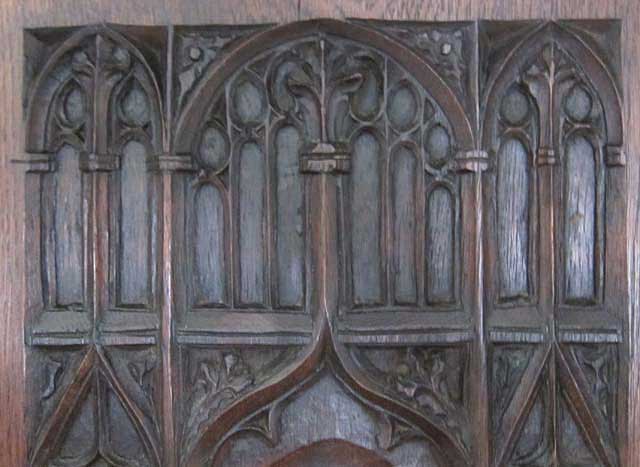
In addition to arches and tracery, another aspect of this cabinet evokes vividly the sense of Gothic cathedral architecture. This is the use of tall slim figures of saints or prophets at the outer edges of the central panel and on the corners of the case.
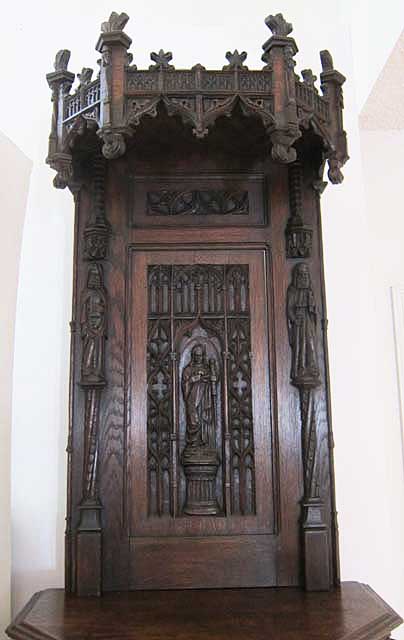
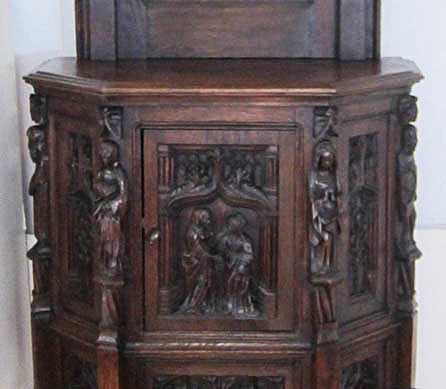
These remind us of the porches of a Gothic cathedrals where elaborately carved canopies shelter "jamb statues" of tall, slim saints, prophets, and rulers lined up on either side of doors. It is as if the cabinet were designed to remind us of the columns of stone out of which each figure is meant to appear transformed.
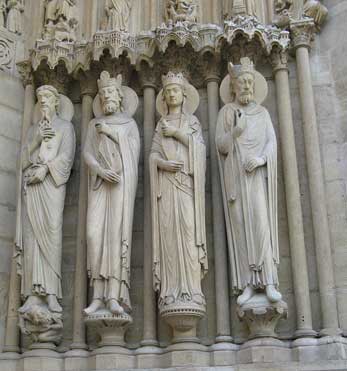
The figures on either side of the upper panel are male, bearded, and carrying a book. According to the standard iconography of the time, that these figures carry books instead of scrolls would make them Apostles. Of the four Evangelists, the writers of the four Gospels, Luke and Mark were not Apostles. So, perhaps these figures on either side of Mary are the Apostles Matthew and John, each carrying a copy of his Gospel.
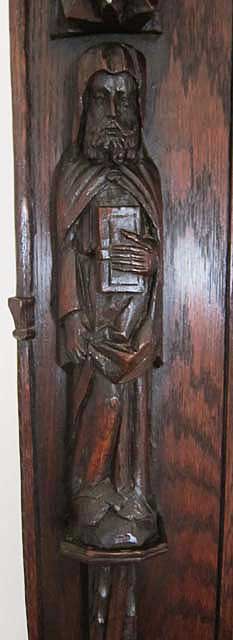

Four smaller figures are at the corners of the case. The two closer to the front are female while the two closer to the back are male. They are shown in poses of devotion, perhaps as pilgrims on the way to one of the shrines devoted to the Virgin Mary.
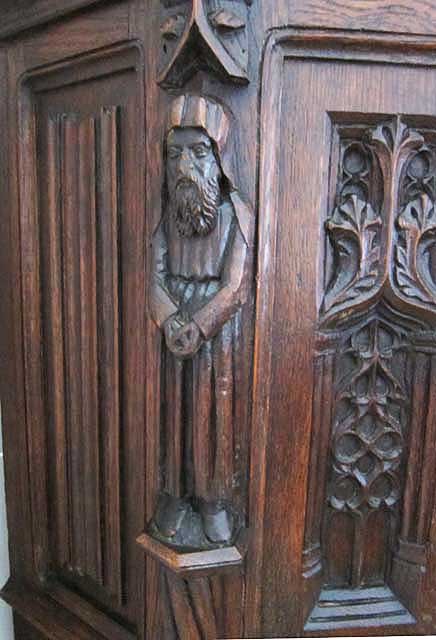
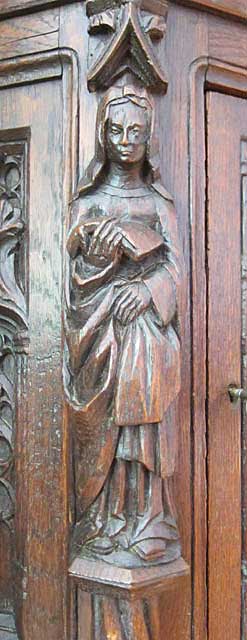
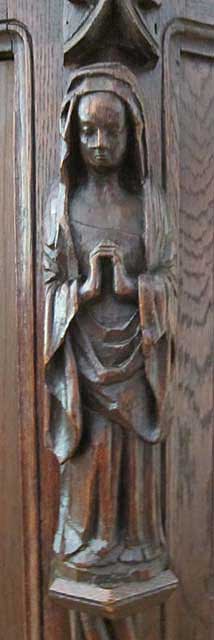
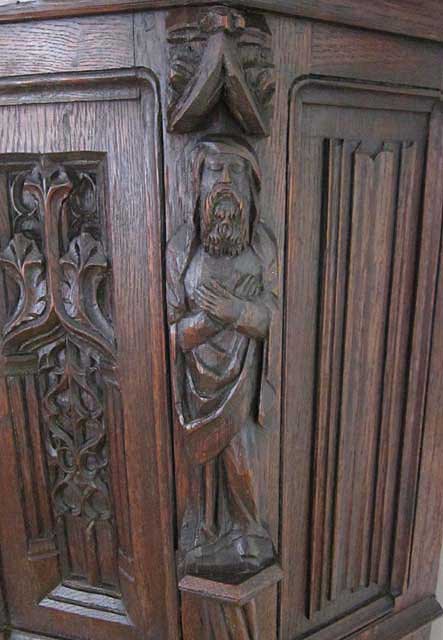
As with all the figures on this cabinet, the detail is extraordinary, especially when one considers that the carving is of hard oak rather than the somewhat softer walnut that was the wood of choice for crafting furniture during the Flamboyant Gothic period of the late Middle Ages.
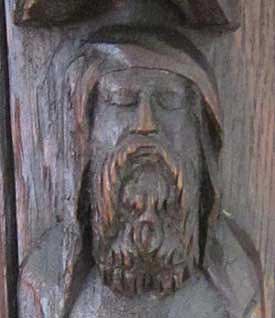
The last of the typical Gothic elements to mention is the linen-fold panel or pli-de-serviette. Resembling a cloth folded in the middle and again on the sides, this is one of the most common elements of Gothic design as well as one open to many variations based on region and period. Here, such panels are seen at the back of the base (pot-board) and on the sides of the case closest to the back.
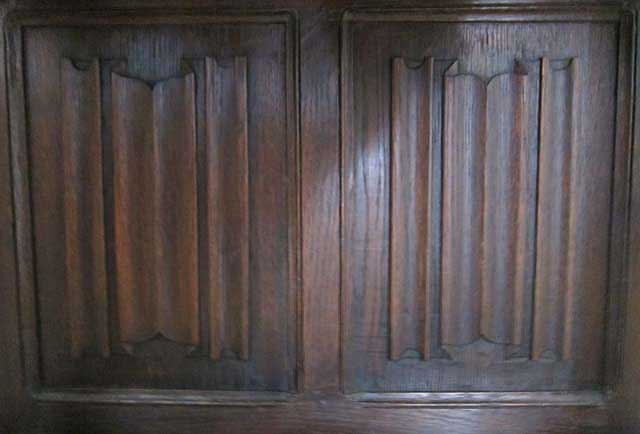
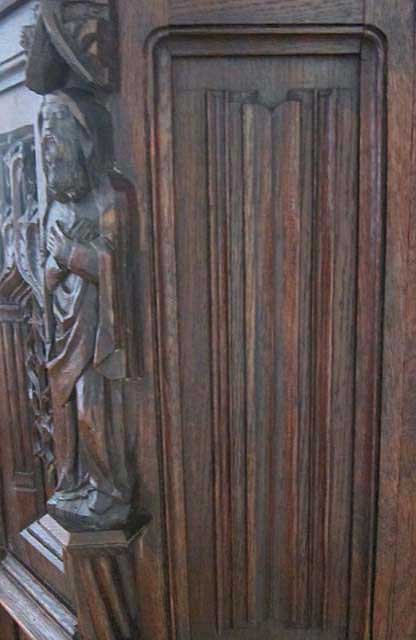
As Gothic cathedrals go, so many of those built during the building boom of the 12th and 13th centuries in northern France were named for the Virgin Mary, including at: Paris, Chartres, Reims, Amiens, Rouen, Laon, and Evreux. For more about them, see the wonderful website Mapping Gothic France, which Andrew Tallon helped to start, as well as his own website detailing his research on the Gothic cathedrals of France. The spirit and the design elements from these extraordinary places have found their way onto this exquisite cabinet.
Since the time of its creation in the 19th century, this cabinet has gone through life in two pieces: the case and the pot-board below it as one, and the back panel with the canopy atop it as the other. The back panel was chained to a wall to keep it from tipping forward while joined together by two flanges attached to the top, to be fastened to the bottom with screws. However, we did not believe that these offered sufficient stability given the extreme height of the piece and we wanted to eliminate the need to chain to top panel to a wall! Our master woodworker installed steel posts screwed to the top and which are then attached to the bottom when the cabinet is erected, in addition to the original flanges.
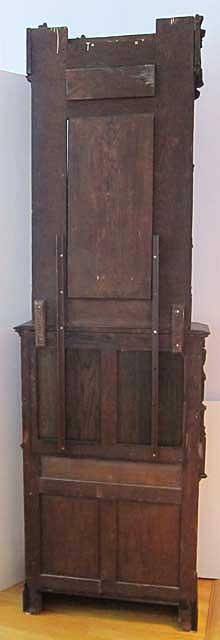
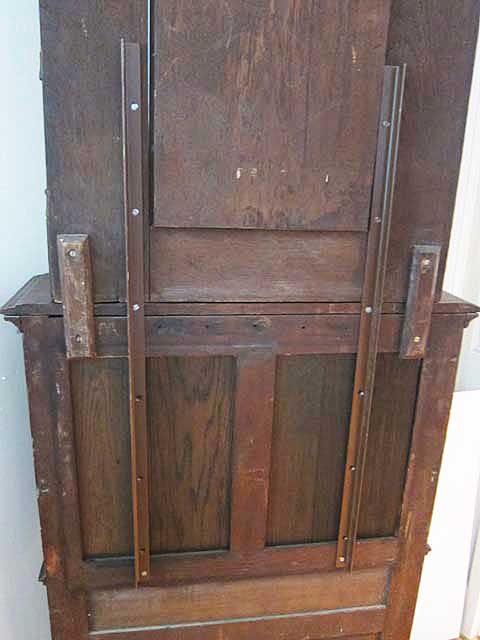
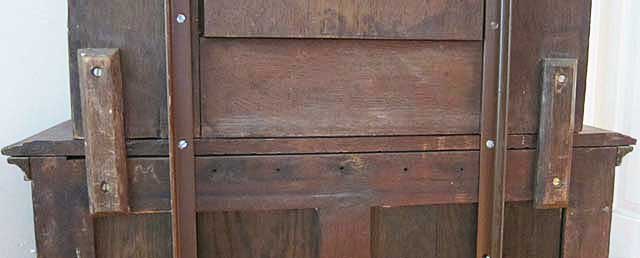
Additional photos are below.
Reference
Boccador, Jacqueline, Le Mobilier Français du Moyen Age à la Renaissance (Editions d'Art Monelle Hayot, Saint-Just-en-Chaussée, 1988); Boccador, Jacqueline, Temple du Temps, qu'un seul soupir résume..., (JMG, Paris, 2002); Charles, Corinne, Visions d'Intérieurs, du Meuble au Décor (Paris-Musées, Paris, 2003) Lightbown, R. W., Carlo Crivelli (Yale University Press, 2004); Stemp, Richard, The Secret Language of the Renaissance, (Duncan Baird, London, 2006); Thirion, Jacques, Le Mobilier du Moyen Age et de la Renaissance en France (Editions Faton, Dijon, 1998); Tissier de Mallerais, Martine, Entre Perche et Sologne — Images des Saints en Loir-et-Cher (Rencontre avec le Patrimoine Religieux, 2019); *Viollet-le-Duc, Eugène, Le Mobilier Médiéval (Georges Bernage, editor) (Editions Heimdal, 2003)
Uses
Owing to its height, this piece will require a large space with a high ceiling and the room to stand it up once it is assembled. It would look beautiful between our French Gothic armchairs 5213 whose ornamentation — especially the abundance of lancet arches — would complement the argenterie.

